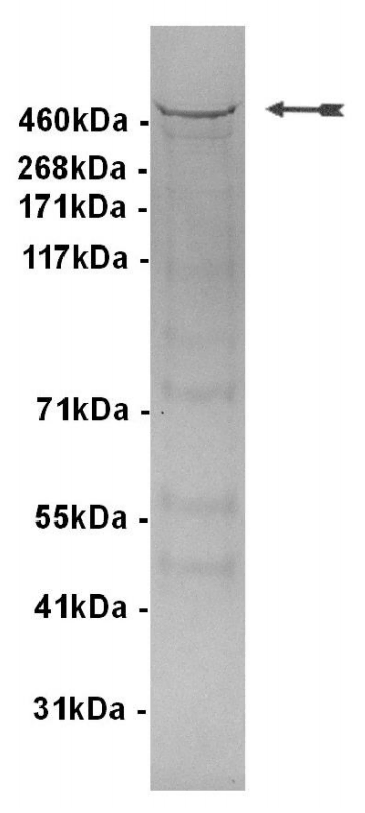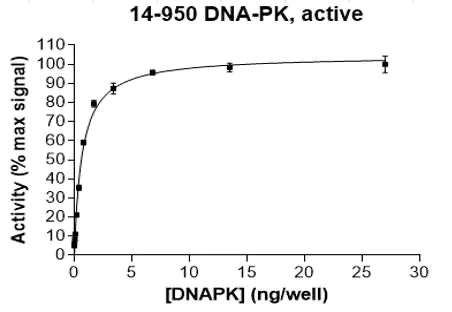DNA-PK, active Human Recombinant Kinase Protein
Recombinant, human FLAG-tagged DNA-PK full length.
Biological information
Background
DNA-PK is a serine/threonine-protein kinase that acts as a molecular sensor for DNA damage. Involved in DNA non-homologous end joining (NHEJ) required for double-strand break (DSB) repair and V(D)J recombination. Must be bound to DNA to express its catalytic properties. Promotes processing of hairpin DNA structures in V(D)J recombination by activation of the hairpin endonuclease artemis (DCLRE1C). Recruited by XRCC5 and XRCC6 to DNA ends and is required to protect and align broken ends of DNA, thereby preventing their degradation, and sequester the DSB for repair by NHEJ. Act as a scaffold protein to aid the localization of DNA repair proteins to the site of damage. The assembly of the DNA-PK complex at DNA ends is also required for the NHEJ ligation step. Found at the ends of chromosomes, suggesting a further role in the maintenance of telomeric stability and the prevention of chromosomal end fusion (By similarity). Also involved in modulation of transcription.
Target class
Kinase
Family
Atypical
Accession number
NM_006904.6
Target Name
DNA-PK, active Human Recombinant Kinase Protein
Target Alias
Origin
Human
Theori. MW
470 kDa
Affinity tag
FLAG
Product specifications
Expression system
Expressed in a mammalian cell line
Purity
Purity 67% by SDS-PAGE and Coomassie blue staining.
Purification method
Sample Buffer
Protein in storage buffer.
Specified activity
Refer to CoA
Application
For Research Only
Storage conditions
1 year at -70°C
Usage disclaimer
For Research Only
Chemical data
Background
DNA-PK is a serine/threonine-protein kinase that acts as a molecular sensor for DNA damage. Involved in DNA non-homologous end joining (NHEJ) required for double-strand break (DSB) repair and V(D)J recombination. Must be bound to DNA to express its catalytic properties. Promotes processing of hairpin DNA structures in V(D)J recombination by activation of the hairpin endonuclease artemis (DCLRE1C). Recruited by XRCC5 and XRCC6 to DNA ends and is required to protect and align broken ends of DNA, thereby preventing their degradation, and sequester the DSB for repair by NHEJ. Act as a scaffold protein to aid the localization of DNA repair proteins to the site of damage. The assembly of the DNA-PK complex at DNA ends is also required for the NHEJ ligation step. Found at the ends of chromosomes, suggesting a further role in the maintenance of telomeric stability and the prevention of chromosomal end fusion (By similarity). Also involved in modulation of transcription.
Compound name
Kinase
Catalog number
14-950
Molecular formula
CAS
MW
Ka
Percent composition
Product specifications
Physical state
Purity (HPLC 214nm)
Retention time (RP18 HPLC)
CMC
Exact mass
Stability
For Research Only
Solubility structure
Kinase Activity Assay Biological information
Background
DNA-PK is a serine/threonine-protein kinase that acts as a molecular sensor for DNA damage. Involved in DNA non-homologous end joining (NHEJ) required for double-strand break (DSB) repair and V(D)J recombination. Must be bound to DNA to express its catalytic properties. Promotes processing of hairpin DNA structures in V(D)J recombination by activation of the hairpin endonuclease artemis (DCLRE1C). Recruited by XRCC5 and XRCC6 to DNA ends and is required to protect and align broken ends of DNA, thereby preventing their degradation, and sequester the DSB for repair by NHEJ. Act as a scaffold protein to aid the localization of DNA repair proteins to the site of damage. The assembly of the DNA-PK complex at DNA ends is also required for the NHEJ ligation step. Found at the ends of chromosomes, suggesting a further role in the maintenance of telomeric stability and the prevention of chromosomal end fusion (By similarity). Also involved in modulation of transcription.
Target class
Kinase
Family
Atypical
Subfamily
Protein Name
DNA-PK
Protein Alias
Accession Number
NM_006904.6
UniProt Number
Gene Name
Gene ID
Gene Aliases
Target Species
Human
Kinase Activity Assay Usage
Product Type
Application
Storage Conditions
1 year at -70°C
Usage disclaimer
Kinase Activity Assay Information
Assay Type
Assay Measures
Biological Information
Background
DNA-PK is a serine/threonine-protein kinase that acts as a molecular sensor for DNA damage. Involved in DNA non-homologous end joining (NHEJ) required for double-strand break (DSB) repair and V(D)J recombination. Must be bound to DNA to express its catalytic properties. Promotes processing of hairpin DNA structures in V(D)J recombination by activation of the hairpin endonuclease artemis (DCLRE1C). Recruited by XRCC5 and XRCC6 to DNA ends and is required to protect and align broken ends of DNA, thereby preventing their degradation, and sequester the DSB for repair by NHEJ. Act as a scaffold protein to aid the localization of DNA repair proteins to the site of damage. The assembly of the DNA-PK complex at DNA ends is also required for the NHEJ ligation step. Found at the ends of chromosomes, suggesting a further role in the maintenance of telomeric stability and the prevention of chromosomal end fusion (By similarity). Also involved in modulation of transcription.
Target class
Kinase
Family
Atypical
Accession Number
NM_006904.6
Target Name
DNA-PK
Target Alias
Origin
Human
Theoretical MW
Affinity Tag
FLAG
Product Specifications
Expression system
Expressed in a mammalian cell line
Purity
Purity 67% by SDS-PAGE and Coomassie blue staining.
Purification method
Sample Buffer
Specified activity
Refer to CoA
Application
Storage conditions
1 year at -70°C
Usage disclaimer
For Research Only
Biological Information
Background
DNA-PK is a serine/threonine-protein kinase that acts as a molecular sensor for DNA damage. Involved in DNA non-homologous end joining (NHEJ) required for double-strand break (DSB) repair and V(D)J recombination. Must be bound to DNA to express its catalytic properties. Promotes processing of hairpin DNA structures in V(D)J recombination by activation of the hairpin endonuclease artemis (DCLRE1C). Recruited by XRCC5 and XRCC6 to DNA ends and is required to protect and align broken ends of DNA, thereby preventing their degradation, and sequester the DSB for repair by NHEJ. Act as a scaffold protein to aid the localization of DNA repair proteins to the site of damage. The assembly of the DNA-PK complex at DNA ends is also required for the NHEJ ligation step. Found at the ends of chromosomes, suggesting a further role in the maintenance of telomeric stability and the prevention of chromosomal end fusion (By similarity). Also involved in modulation of transcription.
Target class
Kinase
Family
Atypical
Accession Number
NM_006904.6
Target Name
DNA-PK
Target Alias
Origin
Human
Theoretical MW
Affinity Tag
FLAG
Product Specifications
Expression system
Expressed in a mammalian cell line
Purity
Purity 67% by SDS-PAGE and Coomassie blue staining.
Purification method
Sample Buffer
Specified activity
Refer to CoA
Application
Storage conditions
1 year at -70°C
Usage disclaimer
For Research Only





